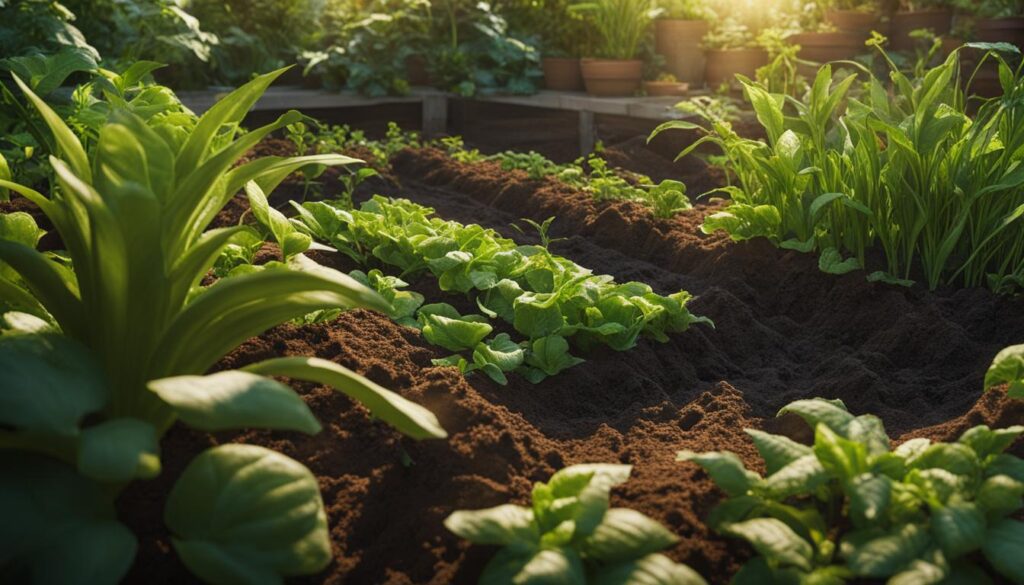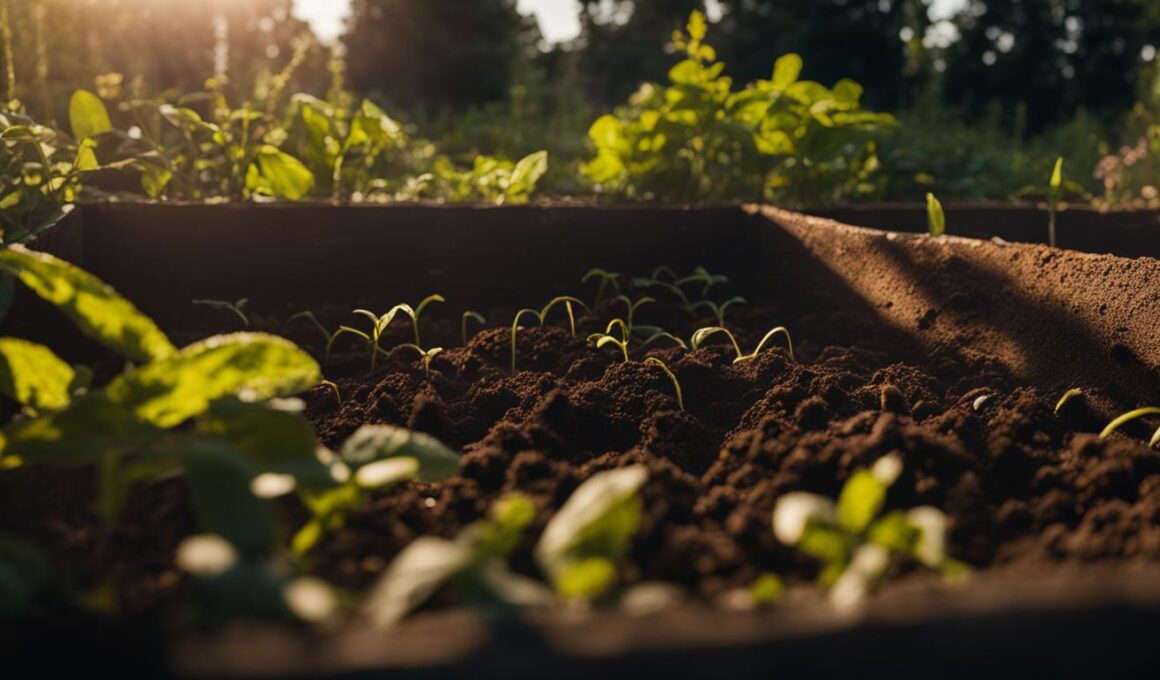Welcome to our article on whether or not you should add worms to your raised garden bed. If you’re looking to enhance the soil and improve the health of your plants, adding worms can be a beneficial option to consider. In this article, we will explore the benefits of adding worms to your garden, the specific considerations for raised beds, the types of worms suitable for raised garden beds, and how to add and care for worms in your raised garden bed.
Post Summary:- Adding worms to your raised garden bed can improve soil quality and enhance plant health.
- Considerations such as bed type and creating a worm-friendly environment are important when adding worms to raised garden beds.
- Red wigglers and nightcrawlers are commonly used worms for raised garden beds.
- Methods for adding worms include placing them in small holes or practicing vermicomposting.
- Creating a worm-friendly environment involves providing the right moisture and food sources for different types of worms.
The Benefits of Adding Worms to your Garden
Adding worms to your raised garden bed can have numerous benefits for the soil quality and plant health. By introducing these amazing creatures into your garden, you can expect to see improvements in various aspects of your gardening experience. Here are some of the key benefits:
- Enhanced Soil Quality: Worms play a crucial role in improving soil quality. They enhance water infiltration, allowing moisture to reach plant roots more efficiently. Improved soil aeration promotes healthier root development, leading to stronger and more vibrant plants. Additionally, worms contribute to the formation of soil aggregates, which create a favorable environment for beneficial microorganisms.
- Increased Nutrient Availability: Worms are nature’s efficient recyclers. They consume organic matter, such as plant debris and kitchen scraps, and break it down into nutrient-rich castings. These castings are a valuable source of nutrients for plants, making them more readily available for uptake. By incorporating worms into your garden, you can enhance the nutrient cycling process, promoting optimal plant growth.
- Improved Composting: If you’re into composting, worms are your best friends. They accelerate the decomposition of organic matter, turning it into nutrient-dense compost. By adding worms to your garden, you can expedite the composting process and enjoy a steady supply of homemade fertilizer.
- Pest Control: Worms attract beneficial predators such as birds and toads, which feed on harmful garden pests. By creating a worm-friendly environment, you can encourage a diverse ecosystem in your garden, where natural pest control is at play.
These are just a few of the many benefits that worms can bring to your garden. By harnessing their natural abilities, you can create a thriving, sustainable garden with improved soil quality and healthier plants.

Comparing the Benefits of Adding Worms
| Benefit | Soil Quality | Plant Health | Pest Control |
|---|---|---|---|
| Enhanced soil structure | ✓ | ||
| Improved water infiltration | ✓ | ||
| Increased nutrient availability | ✓ | ✓ | |
| Accelerated composting | ✓ | ||
| Natural pest control | ✓ |
Considerations for Adding Worms to Raised Garden Beds
If you’re considering adding worms to your raised garden bed, there are a few important considerations to keep in mind. Raised beds offer numerous benefits, such as improved drainage and better control over the soil composition, but they may not always create an ideal environment for worms to thrive. Here are some key factors to consider:
Types of Beds: Not all raised beds are suitable for worms. Elevated beds or those with enclosed bottoms can cause issues like heat and dryness, limited burrowing space, and increased risk of drowning for the worms. It’s best to have open-bottomed beds that allow worms to move freely in and out of the soil.
Worm-Friendly Environment: Creating a worm-friendly environment is crucial to their success in raised beds. This means replicating their natural habitat as much as possible. Ensure the bed has enough organic matter, like compost or decomposing leaves, to provide food for the worms. Additionally, maintain proper moisture levels by regularly watering the bed and using mulch or a cover crop to retain moisture.
Soil Quality: Before adding worms to your raised garden bed, it’s important to ensure the soil quality is suitable for their survival. Conduct a soil test to check for pH levels, nutrient content, and overall health. Worms prefer soil with a pH between 6 and 7, and high organic matter content. If needed, amend the soil with organic matter like compost or worm castings to improve its quality.
By considering these factors, you can create an optimal environment for worms to thrive in your raised garden bed. This will not only benefit the worms themselves but also contribute to healthier soil and improved plant growth.
Types of Worms for Raised Garden Beds
When considering adding worms to your raised garden bed, it’s important to choose the right type of worms that are suitable for this environment. The two commonly used types of worms for raised garden beds are red wigglers (Eisenia fetida) and nightcrawlers (Lumbricus terrestris).
Red wigglers, also known as red worms or compost worms, are small and well-suited for raised beds. They are excellent composters and prefer to stay near the surface of the soil. Red wigglers thrive in organic matter-rich environments and can consume large amounts of kitchen scraps, plant debris, and other organic materials. Their castings, known as vermicompost, are nutrient-rich and help improve soil fertility.
Nightcrawlers, on the other hand, are larger worms that burrow deeper into the soil. They are suitable for raised beds with more compacted earth. Nightcrawlers play an essential role in soil aeration and drainage. Their burrowing activities create channels that allow water and air to penetrate the soil, promoting healthier root development. Nightcrawler castings also contribute to nutrient cycling and soil enrichment.
Both red wigglers and nightcrawlers have their unique benefits and can contribute to the overall health and productivity of your raised garden bed. Consider the specific needs of your plants and the characteristics of your soil when deciding which type of worms to introduce into your garden.

Comparison of Red Wigglers and Nightcrawlers for Raised Garden Beds
| Red Wigglers | Nightcrawlers | |
|---|---|---|
| Size | Small | Large |
| Preferred Soil Depth | Near the surface | Deeper burrows |
| Composting Activity | Excellent composters | Contribute to nutrient cycling |
| Soil Aeration | Minimal | Significant |
| Water Infiltration | Helps retain moisture at the surface | Aids in drainage and water penetration |
This table provides a quick comparison between red wigglers and nightcrawlers in terms of size, preferred soil depth, composting activity, soil aeration, and water infiltration. Use this information to make an informed decision about which type of worms is best suited for your raised garden bed.
How to Add Worms to Your Raised Garden Bed
Adding worms to your raised garden bed is a simple and effective way to improve the overall health of your plants and soil. There are a few different methods you can use to introduce worms into your garden bed, depending on your preferences and the specific needs of your plants.
“One simple approach is to dig small holes in your garden bed and place a bit of moistened compost in each hole. Then, add the worms and cover them with soil,” suggests gardening expert Jane Adams. “This method allows the worms to establish themselves and begin composting right away.”
Another popular method is vermicomposting, which involves using worms to convert organic matter into fertilizer. This can be done directly in your raised bed by providing a food source for the worms. Simply add kitchen scraps, garden waste, or other organic materials to a designated area of your garden bed and let the worms do their work.
Remember to create a worm-friendly environment by keeping the soil moist and providing a mixture of mulch and compost for the worms to feed on. This will help ensure their survival and allow them to thrive in your raised garden bed.
Summary
When it comes to adding worms to your raised garden bed, there are a few key steps to follow:
- Create small holes in the soil and place moistened compost in each hole before adding the worms.
- Alternatively, practice vermicomposting by adding kitchen scraps or garden waste directly to your raised bed.
- Maintain a worm-friendly environment by keeping the soil moist and providing a mixture of mulch and compost for the worms to feed on.
By following these methods and considerations, you can successfully add worms to your raised garden bed and enjoy the many benefits they bring to your plants and soil.
Ensuring the Survival and Thriving of Worms in Raised Garden Beds
To ensure the survival and thriving of worms in your raised garden bed, it is crucial to create a worm-friendly environment that meets their specific needs. This includes providing adequate water and a suitable food source for the worms.
Water
Worms need a moist environment to survive, as they breathe through their skin, which needs to stay damp. To maintain a worm-friendly environment, you can water your raised garden bed regularly, ensuring that the soil remains moist but not waterlogged. A layer of mulch or compost can help retain moisture in the soil and provide a comfortable habitat for the worms.
Food Source
For worms to thrive in your raised garden bed, it is essential to provide them with a suitable food source. They primarily feed on organic matter such as kitchen scraps, coffee grounds, and leafy greens. By incorporating these food sources into your raised bed, you can create a nutrient-rich environment that supports the growth and reproduction of worms.
Additionally, it is crucial to avoid adding substances that are harmful to worms, such as pesticides or chemical fertilizers. These can disrupt the delicate balance of the worm ecosystem and have detrimental effects on their health.
By creating a worm-friendly environment and providing adequate water and food, you can ensure the survival and thriving of worms in your raised garden bed. This will not only benefit the worms but also contribute to healthier soil and improved plant growth in your garden.
Number of Worms to Add to a Raised Garden Bed
When it comes to adding worms to your raised garden bed, it’s essential to consider the right number of worms to ensure a positive impact on the soil and plant health. As a general guideline, it is recommended to add around 5-10 worms per square meter of your garden bed. However, this number can vary depending on the size of your bed and the specific needs of the plants you are growing.
By adding the appropriate number of worms, you can create a balanced ecosystem that promotes healthy soil and plant growth. Worms play a vital role in improving soil quality by enhancing water infiltration, soil aeration, and nutrient availability. They help break down organic matter, enrich the soil with their castings, and create channels for root growth.
When determining the number of worms to add, consider the size of your raised garden bed. If you have a larger bed, you may need to increase the number of worms to ensure optimal soil health. Additionally, if you are growing plants with high nutrient demands, such as vegetables or flowering plants, providing a slightly higher number of worms can be beneficial.
The key is to strike a balance and ensure that the worms have enough organic matter to feed on and create a healthy environment. Adding too few worms may not have a significant impact, while adding too many worms can lead to competition for resources and potential overcrowding. Therefore, it’s important to assess your bed’s size and the specific needs of your plants to determine the ideal number of worms to add.
| Size of Raised Garden Bed | Ideal Number of Worms |
|---|---|
| Small (1 square meter) | 5-7 worms |
| Medium (2-3 square meters) | 10-15 worms |
| Large (4-6 square meters) | 20-30 worms |
Remember, adding worms to your raised garden bed is a natural and sustainable way to improve soil fertility and plant health. By considering the appropriate number of worms and providing them with a suitable environment, you can create an ecosystem that supports thriving and productive gardening.
Do Worms Help with Drainage in Raised Garden Beds?
Worms play a significant role in improving drainage for raised garden beds. These tiny creatures burrow through the soil, creating channels that allow water to flow freely. By breaking down organic matter, worms enrich the soil and prevent it from becoming compacted, ensuring proper drainage for healthy plant growth.
Conclusion
Adding worms to your raised garden bed can greatly benefit the overall health and productivity of your garden. By creating a worm-friendly environment and selecting the appropriate type of worms, you can improve soil quality and enhance plant vitality.
It is important to consider the specific considerations for raised beds when adding worms. Elevated beds or those with enclosed bottoms may not be suitable as they can lead to issues such as heat and dryness or limited burrowing space for the worms. To provide a habitat that replicates their natural environment, ensure your raised bed allows for proper drainage and offers ample food sources for the worms.
There are two types of worms commonly used in raised garden beds: red wigglers and nightcrawlers. Red wigglers are excellent composters and prefer to stay near the surface, making them ideal for raised beds. On the other hand, nightcrawlers burrow deeper into the soil and are well-suited for beds with compacted earth.
When adding worms to your raised garden bed, it is recommended to include around 5-10 worms per square meter. However, this can vary depending on the size of your bed and the specific needs of your plants. Providing an adequate number of worms ensures they can have a positive impact on both the soil and plant health.
In summary, incorporating worms into your raised garden bed can create a thriving ecosystem. By considering the specific needs of raised beds, selecting the right type of worms, and maintaining a proper balance, you can enjoy the benefits of improved soil quality and healthier plants.
Can Adding Worms to Your Garden Bed Help with Soil Health?
Adding worms to your garden bed can greatly improve soil health. Worms help to aerate the soil, improve drainage, and mix organic matter into the soil. They also play a crucial role in the nutrient cycle, breaking down organic material and increasing microbial activity. Removing earthworms from soil can have negative effects on soil health and fertility.
FAQ
What are the benefits of adding worms to a raised garden bed?
Adding worms to your raised garden bed can enhance soil quality, improve water infiltration and soil aeration, relieve compaction, and make nutrients more accessible to plants.
What considerations should I keep in mind when adding worms to a raised garden bed?
Ensure that your raised bed is not elevated or has an enclosed bottom, as worms require burrowing space and a suitable environment. Create a worm-friendly habitat similar to their natural habitat.
What types of worms are suitable for raised garden beds?
Two commonly used types of worms for raised garden beds are red wigglers (Eisenia fetida), which prefer staying near the surface and are excellent composters, and nightcrawlers (Lumbricus terrestris), which burrow deeper into the soil.
What are some methods for adding worms to a raised garden bed?
You can dig small holes, place moistened compost in each hole, add the worms, and cover them with soil. Another method is vermicomposting, where worms are used to convert organic matter into fertilizer directly in the raised bed.
How can I ensure the survival and thriving of worms in my raised garden bed?
Keep the soil moist for worms near the surface by using mulch or compost as a cover. Provide access to the bottom of the bed and a mixture of mulch and compost in the soil for worms that prefer deeper soil.
How many worms should I add to my raised garden bed?
It is recommended to add around 5-10 worms per square meter of your raised garden bed, but this number can vary depending on the size of your bed and the specific needs of your plants.









